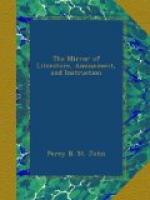THE MIRROR OF LITERATURE, AMUSEMENT, AND INSTRUCTION.
Vol. XIV, No. 395.] Saturday, October 24, 1829. [Price 2d.
* * * * *
[Illustration]
The Original Royal Exchange.
(From a Correspondent.)
Four centuries since the Merchants of London could not boast of a public Exchange. They then assembled to transact business in Lombard-street, among the Lombard Jews, from whom the street derives its name, and who were then the bankers of all Europe. Here too they probably kept their benches or banks, as they were wont to do in the market-places of the continent, for transacting pecuniary matters; and thus drew around them all those of whose various pursuits money is the common medium.
At length, in 1534, Sir R. Gresham, who was agent for Henry the Eighth at Antwerp, and had been struck with the advantages attending the Bourse, or Exchange, of that city, prevailed upon his Royal Master to send a letter to the Mayor and Commonalty of London, recommending them to erect a similar building on their manor of Leadenhall. The Court of Common Council, however, were of opinion that such a removal of the seat of business would be impracticable, and the scheme was therefore dropped; but in the reign of Queen Elizabeth, Sir Thomas Gresham, who succeeded to the Antwerp agency, happily accomplished what had been denied to the hopes of his father. In 1564 Sir Thomas proposed to the Corporation—“That if the City would give him a piece of ground, in a commodious spot, he would erect an Exchange at his own expense, with large and covered walks, wherein the merchants might assemble and transact business at all seasons, without interruption from the weather, or impediments of any kind.” The Corporation met the proposal with a spirit of equal liberality; and in 1566 various buildings, houses, tenements, &c. in Cornhill, were purchased for rather more than L3,530, and the materials re-sold for L478, on condition of pulling them down and carrying them away.—The ground plot was then levelled at the charge of the City, and possession given to Sir Thomas, who in the deed is styled, “Agent to the Queen’s Highness,” and who laid the foundation of the new Exchange on the 7th of June following; and the whole was covered in before November 1567.
The plan adopted by Sir Thomas, in the formation of his building, was similar to the one at Antwerp. An open area was inclosed by a quadrangle of lofty stone-buildings, with a colonnade as at present, supported, by marble columns of the Doric order, over which ran a cornice, with Ionic pilasters above, having niches between, containing statues of the English Sovereigns. The entrances were from Cornhill and Broad-street. Over the first, between two Ionic three-quarter columns, were the Royal Arms, and on either side were those of the City and Sir Thomas; on the north side, but not exactly in the centre, rose a Corinthian pillar to about the same height as the tower in front surmounted with the grasshopper. In every other respect it was similar to the south, of which the previous engraving is a view.




